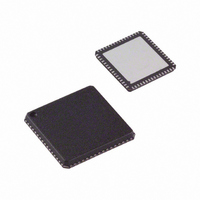AD9520-5BCPZ-REEL7 Analog Devices Inc, AD9520-5BCPZ-REEL7 Datasheet - Page 40

AD9520-5BCPZ-REEL7
Manufacturer Part Number
AD9520-5BCPZ-REEL7
Description
12/24-Output Clock Generator
Manufacturer
Analog Devices Inc
Type
Clock Generator, Fanout Distributionr
Datasheet
1.AD9520-5BCPZ.pdf
(80 pages)
Specifications of AD9520-5BCPZ-REEL7
Design Resources
Synchronizing Multiple AD9910 1 GSPS Direct Digital Synthesizers (CN0121) Phase Coherent FSK Modulator (CN0186)
Pll
Yes
Input
CMOS, LVDS, LVPECL
Output
CMOS, LVPECL
Number Of Circuits
1
Ratio - Input:output
2:12, 2:24
Differential - Input:output
Yes/Yes
Frequency - Max
2.4GHz
Divider/multiplier
Yes/No
Voltage - Supply
3.135 V ~ 3.465 V
Operating Temperature
-40°C ~ 85°C
Mounting Type
Surface Mount
Package / Case
64-LFCSP
Frequency-max
1.6GHz
Lead Free Status / RoHS Status
Lead free / RoHS Compliant
AD9520-5
Clock Frequency Division
The total frequency division is a combination of the VCO
divider (when used) and the channel divider. When the VCO
divider is used, the total division from the CLK to the output is
the product of the VCO divider (1, 2, 3, 4, 5, and 6) and the
division of the channel divider. Table 28 indicates how the
frequency division for a channel is set.
Table 28. Frequency Division
VCO Divider
Setting
1 to 6
1 to 6
2 to 6
1
VCO divider
bypassed
VCO divider
bypassed
1
The channel dividers feeding the output drivers contain one
2-to-32 frequency divider. This divider provides for division-by-1
to division-by-32. Division-by-1 is accomplished by bypassing
the divider. The dividers also provide for a programmable duty
cycle, with optional duty-cycle correction when the divide ratio
is odd. A phase offset or delay in increments of the input clock
cycle is selectable. The channel dividers operate with a signal at
their inputs up to 1600 MHz. The features and settings of the
dividers are selected by programming the appropriate setup
and control registers (see Table 44 through Table 55).
VCO Divider
The VCO divider provides frequency division between the CLK
input and the clock distribution channel dividers. The VCO
divider can be set to divide by 1, 2, 3, 4, 5, or 6 (see Table 51,
0x1E0[2:0]). However, when the VCO divider is set to 1, none
of the channel output dividers can be bypassed.
The VCO divider can also be set to static, which is useful for
applications where the only desired output frequency is the
CLK input frequency. Making the VCO divider static increases
the wide band spurious-free dynamic range (SFDR). An
alternative to achieving the same SFDR performance is to set
the VCO divider to 1 and enable CLK direct mode.
Channel Dividers
A channel divider drives each group of three LVPECL outputs.
There are four channel dividers (0, 1, 2, and 3) driving 12 LVPECL
outputs (OUT0 to OUT11). Table 29 gives the register locations
used for setting the division and other functions of these dividers.
The division is set by the values of M and N. The divider can be
bypassed (equivalent to divide-by-1, divider circuit is powered
down) by setting the bypass bit. The duty-cycle correction can
The bypass VCO divider (0x1E1[0] = 1) is not the same as VCO divider = 1.
1
Channel
Divider
Setting
Don’t care
2 to 32
Bypass
Bypass
Bypass
2 to 32
CLK Direct-
to-Output
Setting
Enable
Disable
Disable
Disable
Don’t care
Don’t care
Resulting
Frequency
Division
1
(1 to 6) × (2 to 32)
(2 to 6) × (1)
Output static
(illegal state)
1
2 to 32
Rev. 0 | Page 40 of 80
be enabled or disabled according to the setting of the disable
divider DCC bits.
Table 29. Setting D
Divider
0
1
2
3
Channel Frequency Division (0, 1, 2, and 3)
For each channel (where the channel number x is 0, 1, 2, or 3),
the frequency division, D
(four bits each, representing Decimal 0 to Decimal 15), where
The high and low cycles are cycles of the clock signal currently
routed to the input of the channel dividers (VCO divider out
or CLK).
When a divider is bypassed, D
Otherwise, D
each channel divider to divide by any integer from 1 to 32.
Duty Cycle and Duty-Cycle Correction
The duty cycle of the clock signal at the output of a channel is a
result of some or all of the following conditions:
•
•
•
•
The DCC function is enabled by default for each channel divider.
However, the DCC function can be disabled individually for
each channel divider by setting the disable divider DCC bit for
that channel.
Certain M and N values for a channel divider result in a non-
50% duty cycle. A non-50% duty cycle can also result with an
even division, if M ≠ N. The duty-cycle correction function
automatically corrects non-50% duty cycles at the channel
divider output to 50% duty cycle.
Duty-cycle correction requires the following channel divider
conditions:
• An even division must be set as M = N.
• An odd division must be set as M = N + 1.
When not bypassed or corrected by the DCC function, the duty
cycle of each channel divider output is the numerical value of
(N + 1)/(N + M + 2) expressed as a percent.
Number of Low Cycles = M + 1
Number of High Cycles = N + 1
The M and N values for the channel
DCC enabled/disabled
VCO divider enabled/bypassed
The CLK input duty cycle
Low Cycles M
0x190[7:4]
0x193[7:4]
0x196[7:4]
0x199[7:4]
X
= (N + 1) + (M + 1) = N + M + 2. This allows
X
for the Output Dividers
X
, is set by the values of M and N
High Cycles N
0x190[3:0]
0x193[3:0]
0x196[3:0]
0x199[3:0]
X
= 1.
Bypass
0x191[7]
0x194[7]
0x197[7]
0x19A[7]
Disable
Div DCC
0x192[0]
0x195[0]
0x198[0]
0x19B[0]














